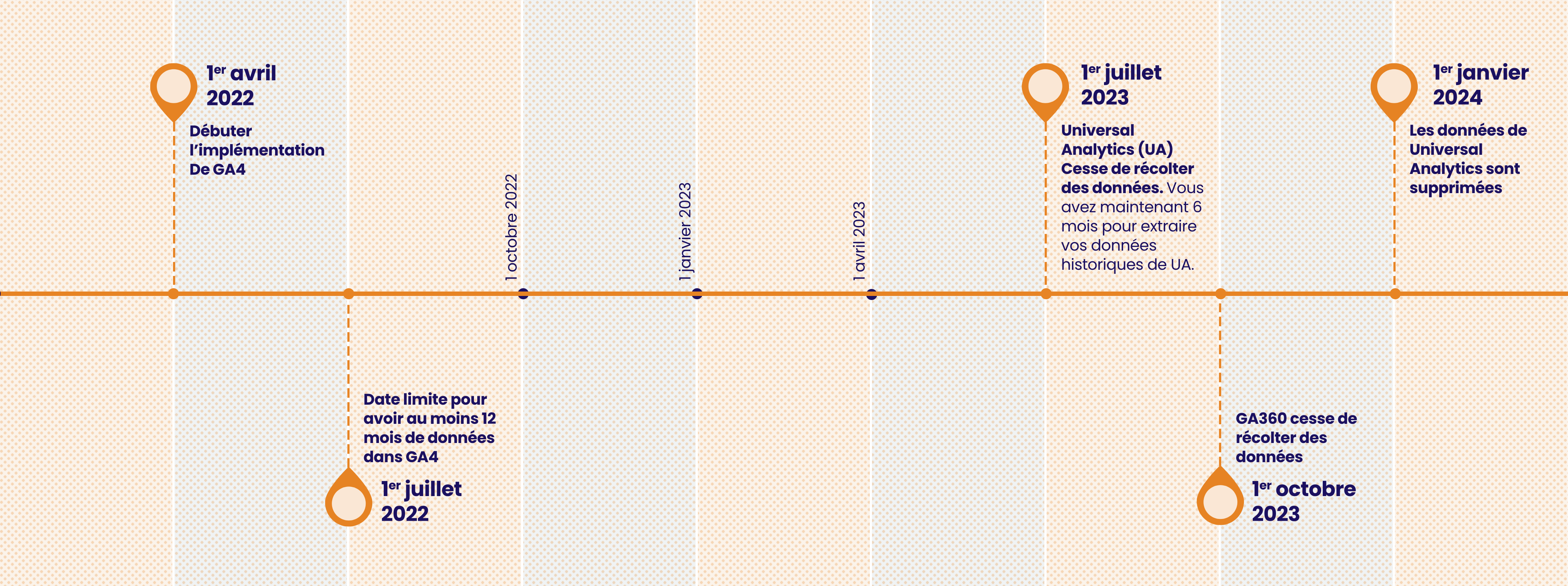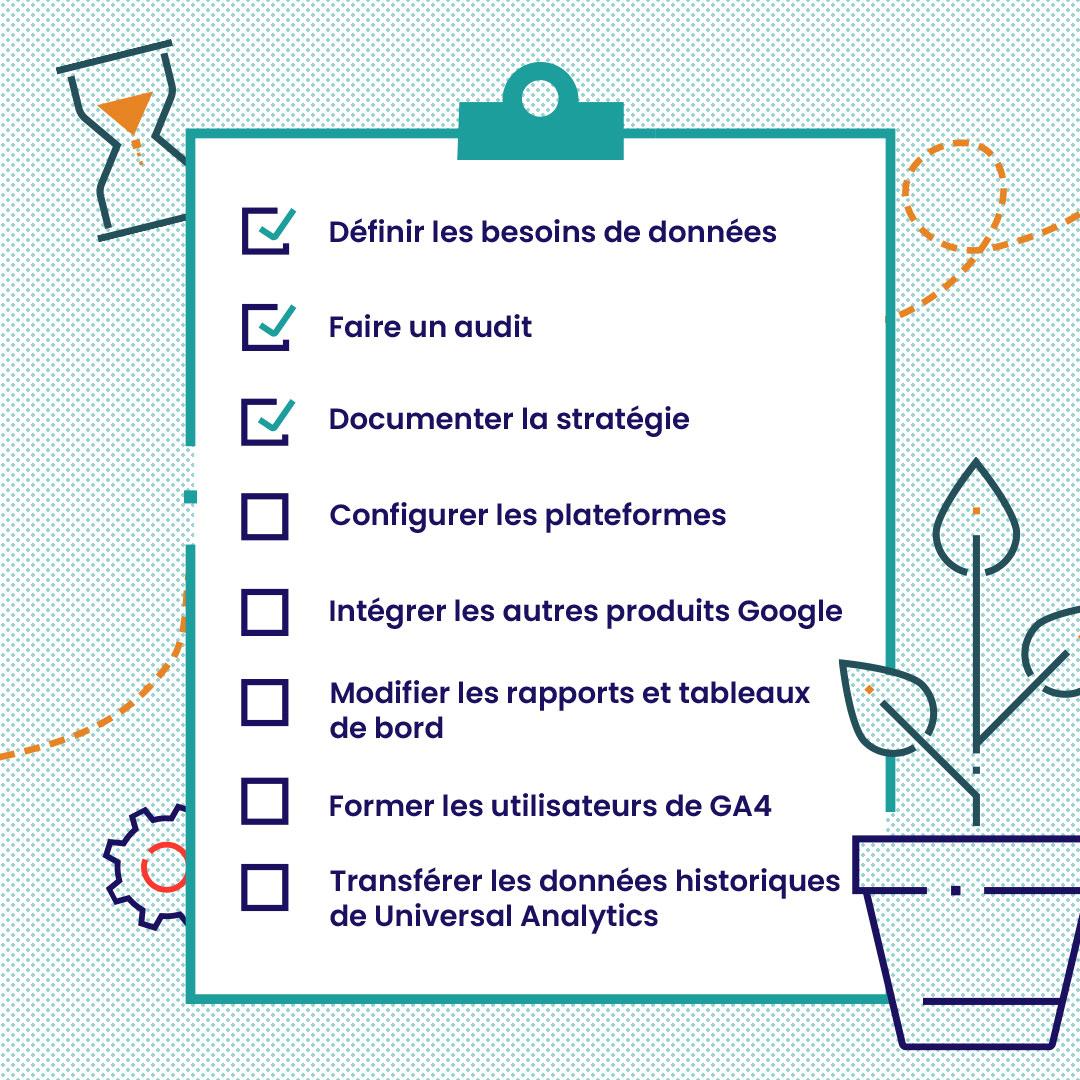Action plan for a successful migration to Google Analytics 4

If anyone tells you it’ll only take two weeks to migrate to Google Analytics 4 (GA4), you should be skeptical.
Remember that movie The Money Pit, starring a young Tom Hanks? Centred on a home reno that turns into a nightmare, the film depicts project management at its worst. When asked how long the work will take, the contractors’ steadfast reply is “Two weeks.” But does the work end up being completed in two weeks? Of course not.
Here’s the real answer to how long it’ll take to migrate to Google Analytics 4: it depends. Disappointing, we know.
More specifically, the time required to upgrade to GA4 depends on the following factors:
- Website complexity: Do you have a transactional site? A blog? Multiple sites or sub-domains? Do you use a CMS?
- Digital ecosystem: Does your site have complementary mobile applications? Does it connect to other platforms such as a data warehouse, customer data platform, or consent management platform?
- Human resources capabilities: Do you have adequate internal resources? Do your resources need training on how to use GA4?
- Current Google Analytics implementation: Do you use Google Tag Manager? Do you use a data layer?
- Data visualization: Is your Google Analytics data linked to dashboards and reports (Google Data Studio, Power BI, Tableau)?
- Marketing needs: Do you integrate Google Analytics with other media platforms to create audiences or measure the performance of your campaigns?
Migrating to GA4 involves much more than changing out the old code for the new. The new version of Google Analytics 4 is very different from Universal Analytics. It’s been completely redesigned, from interface to data structure.
You should therefore allow a certain amount of time to implement and adapt to this new platform. Doing so will also be a great opportunity to wipe the slate clean and define a measurement strategy that meets your current needs..
The countdown has begun
Google has announced that Universal Analytics (UA) will stop collecting data on July 1, 2023 (October 1, 2023, for the paid version, GA360).
Data collection begins once GA4 has been implemented. It is not retroactive. This means that if you would like a year-over-year comparison, you must implement the new version by July 1, 2022. Time is running out!
To help you make a smooth transition to Google Analytics 4, we’ve created an action plan containing the most important elements to consider.

Google Analytics 4 migration guide
- Define measurement strategy data requirements
- Audit the current implementation of Universal Analytics
- Document the strategy using a detailed measurement plan and clear nomenclature
- Implement the code, configure platforms, and perform quality assurance
- Integrate with other Google products
- Modify reports and dashboards
- Train users on the new GA4 interface and features
- Transfer historical data from Universal Analytics
Defining your measurement strategy requirements
The three keys to buying a home are location, location, location. When it comes to implementing GA4, the keys are planning, planning, planning.
This step is crucial. It lays the foundation for your entire project.
You need to define how the data collected will meet your business needs and enable you to make informed decisions. Think about your current needs, but also about your future needs.
Don’t forget to consult with all of your teams to ensure you’re getting the full picture. Your marketing team, for instance, will have different data needs than your e-commerce team or your loyalty program.
Here are some examples of questions that can help guide your measurement strategy planning:
- What business questions are you trying to answer or what questions are being asked?
- What key indicators would you like to see on your dashboard as you sip your morning coffee?
- What primary conversions (related to your business goals) and secondary conversions (related to engagement) help you better understand user behaviour and define success?
- What are you trying to optimize (marketing campaign, user experience, engagement)?
- What data sources do you want to combine with GA4 behavioural data?
Auditing your current implementation
This step involves reviewing your current implementation and configurations to determine what should be carried over into Google Analytics 4.
You definitely won’t want to move all the data you collected in Universal Analytics, as some information will no longer be relevant or worth consulting.
Now is the time to channel your inner Marie Kondo and focus on the quality and usefulness of your data. Instead of “Does this spark joy?” ask yourself, “Does this data still have value?”
If you’ve been using Google Analytics for a few years, you’ll no doubt have some outdated configurations hanging around. For example, are all your exclusion filters still appropriate? Since there’s a limit to how many you can create in GA4, take this opportunity to do a check and tidy things up.
Documenting your measurement strategy
With your data needs defined, you can now translate them into technical requirements. Google Analytics automatically collects certain interactions, but chances are you’ll need more.
The purpose of a measurement plan is to specify what data to collect and how to collect it. It maps out all the information Google Analytics receives, such as interactions (events), user properties, conversions, dimensions, and custom metrics.
Think about the best way to structure your GA4 account so that it can grow with your business in the years to come.
There’s no room to improvise. It’s essential to establish a clear nomenclature in advance for two reasons:
- You want the information in Google Analytics 4 to be clean and intelligible. If you have an application, you should also consider the nomenclature for the application’s interactions.
- There are limitations and restrictions on the collection of certain items. For example, you can have up to 50 custom dimensions. That may sound like a lot, but without clear nomenclature, you can reach this ceiling quickly.
Having a measurement strategy in place makes it easier to plan your migration. You can implement in phases by prioritizing critical data and develop a migration schedule tailored to your team and your organization.
Implementation, configuration, and quality assurance
Your measurement plan also serves as a reference for creating your implementation guide. An implementation guide is a document containing the technical specifications for code integration, which developers need to implement everything correctly.
If you’re not already using a data layer to collect data, this is a good opportunity to upgrade your implementation.
You should also (re)configure your tags in Google Tag Manager to ensure that any data specified in the implementation guide is properly captured in Google Analytics 4..
Keep in mind that the property structure and settings in Google Analytics 4 differ from Universal Analytics. Extra care should be taken when configuring the platform to make sure everything works as expected.
The final element in this step is checking the quality of the implementation in the internal and production environments. Data quality is crucial to making the right decisions, and it starts with how the data is collected.
Integrating Google products
One of the perks of Google Analytics is that it integrates organically with other Google products. With GA4, certain integrations that previously required paid licences are now free.
In addition to Google Ads and Google Search Console, you can link to media platforms such as Display & Video 360 (DV360) and Search Ads 360 (SA360) to activate your audiences.
Take advantage of the option to integrate with Google Cloud’s data warehouse, BigQuery, to export raw data from GA4 at no cost. You will be billed for storage and queries, but this way you’ll always have access to your data since the retention period in GA4 is 14 months.
Remember to adjust your privacy policy to reflect the features you’ve enabled.

Modifying reports and dashboards
All reports and dashboards that use Universal Analytics as a data source will need to be updated. That means changing not only the connectors, but also the content..
You will have to review the data used because some metrics in Google Analytics 4 are different from Universal Analytics (goodbye, bounce rate!). You’ll also want to incorporate the new indicators defined in your measurement plan.
User training
Google Analytics 4 is a completely different experience to Universal Analytics. Whether you use Google Analytics every day or once a month, you’ll need training. Don’t underestimate the learning curve required to be able to properly leverage your data.
Allow a period of adjustment to get your bearings and familiarize yourself with the interface.
Can’t find the landing page report to evaluate the performance of your campaigns? That’s because it doesn’t exist anymore. Don’t worry—you can recreate it with a custom report.
You should also leave yourself time to get to know the new metrics and develop new analysis reflexes.
Unlike UA, which uses a data model based on sessions and page views, GA4 is all about events. Making the switch requires changing the way user behaviour is analyzed and relying more on new analysis tools such as Custom Funnels.
Transferring historical data from Universal Analytics
Google has announced that you will be able to access your Universal Analytics data for at least six months after UA becomes unavailable (July 1, 2023). It’s recommended to export your data for your records.
You won’t be able to reconcile your UA and GA4 data, as each version has its own data model and way of calculating metrics.
For example, your session count should be slightly lower in GA4 because sessions are tallied differently.
Conversely, the number of conversions should be higher in GA4 because it represents the total number of times a user has triggered this event. In UA, if a user generates the same conversion several times in a session, the goal is counted only once.
Switch to GA4 today!
As you can see, migrating to Google Analytics 4 is a substantial project in and of itself. But with a well-thought-out action plan and the right practices in place, it’s possible to build an environment that will benefit your business.
Tink has developed a proven step-by-step framework to support you right from the strategic planning stage to implementation. If you’re ready to maximize the benefits of GA4, don’t hesitate to contact our team of specialists.
